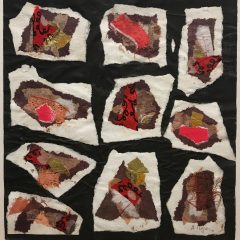Post by Andrea Kirsh

Gego, “Drawing Without Paper 83/9,” 1983. Aluminium hoop, plastic mesh, plastic hoops, enameled iron wire, and metal pieces, 8 1/4 x 7 1/16 x 3/16 inches.
I saw two exhibitions of extraordinary women in NYC last weekend.
Gego
The Drawing Center showed “Gego, Between Transparency and the Invisible”. Very few artists invent a visual language. Gego did. The German-born Gego (an assumed name; she was born Gertrude Goldschmidt) trained as an architect and engineer in Stuttgart before moving to Caracas. She didn’t turn to art until her forties and produced her major work in her fifties. She brought a freedom and inventiveness to her printmaking and sculpture that parallels the sculptor, Harry Bertoia’s work in furniture design during more or less the same period. She was very little known to U.S. audiences before 1996 when her work was included in the ICA, Boston’s exhibition, “Inside the Visible,” where I saw it. It was a revelation to many of us. The Drawing Center is exhibiting prints, drawings and wire works that would usually be described as sculpture or reliefs and suggests that all are related to the idea of drawing.

Gego, “Reticulárea,” 1975. Stainless steel wire, 82 11/16 x 102 3/8 x 7 7/8 inches.
They display a sort of low-tech brilliance. She used every possible means to produce monoprints, which were clearly made without using a press. She drew on the plate, blocked out part of a plate with objects or paper (in what are conceptually print equivalents to photograms) and even tore the paper to produce designs, similarly to Fontana’s cuts. Her sculpture is all fashioned out of wire. Some are constructed in more-or-less two dimensions and hung out from the wall so they interact with their own shadows. A small work resembled a bed-frame with the springs gone hay-wire. At other times she created more three-dimensional pieces. The masterpiece in the show was one of her series of “Reticulareas,” which are mesh-like structures of 3 and 4-sided figures (and occasional straight lines) of steel wire. This one hangs some seven feet tall, and they all bear a resemblance to chemical models of highly-complex substances.
The exhibition was organized by the MFA, Houston (which owns many of the works) and is up through July 21. It is well worth the trip to New York.
Anne Ryan

Anne Ryan, Collage #350, 1950/53, sheet size 8 x 7 inches
I saw another eye-opener at Susan Teller Gallery (not far from the Drawing Center, at 568 Broadway, 212 941-7335), a small overview, not quite a retrospective, of Anne Ryan’s work. Ryan is best known for the collages she made after 1948 when she saw an exhibition of Kurt Schwitters’ work. A couple of these used to be on more-or-less permanent exhibition at MoMA, but that was years ago. I haven’t seen them in decades.

The Wine Glass, about 1945, woodcut on black paper, 16 x 21 inches.
Ryan only began painting in her fifties and her career was but fifteen years. This exhibition has one collage and twenty-seven paintings, drawings and innovative wood-block prints. It traces her experience in Stanley William Hayter’s print studio and her exploration of Constructivism and Surrealism. While her collages have a clear debt to Schwitters, they have their own characteristic palette and delicacy, and rather than the urban detritus favored by Schwitters, Ryan favored varied types of fabric and fine papers, some of it hand-made. Her wood-cuts employ a single block which she inked by hand, in multiple colors of varying transparency which yielded variation within an edition. She often printed on black paper in another sort of artistic recycling (they were the wrappers from photographic film). This gives the work a striking coloration and depth. The exhibition is on through May 12, and should you miss it, the gallery will likely have some of her work available.
The search for more ladies
Speaking of women’s work, after attending the symposium at the opening of the Brooklyn Museum’s “Global Feminisms” last month (post here), I returned to look for work by women at the Philadelphia Museum of Art. The question had arisen as to whether Brooklyn needed a Center for Feminist Art; judging from the Philadelphia situation, the answer is a resounding “YES!”
I only surveyed the PMA’s post-World War Two galleries, a period when women had ready access to art education. And I found an astonishing two works from the painting and sculpture collection: a small painting by Sarah McEaneany in the vestibule where the PMA relegates Philadelphia artists, and a painting by Edna Andrade in the American wing, in an exhibition devoted to Op and Pop Art. If the PMA exhibits Op Art and doesn’t own a Bridget Riley, they could have borrowed one; Pop Art was largely a male affair (although they might have found a Marisol or Nikki de St. Phalle, not to mention the recently revived work of Rosalind Drexler). But the lack of women in the galleries of post-war and contemporary work indicates a real blind spot on the part of the curatorial staff. True, the exhibition of recent prints and drawings includes women, as does the crafts collection (and likely the costumes, as well, but these only feed stereotypes about womens’ production). But paintings and sculpture has the bulk of the space and receives the bulk of attention, and the near absence of women is a serious omission.
–Andrea Kirsh is an art historian based in Philadelphia. You can read her newest Philadelphia Introductions and other commentary at InLiquid.









